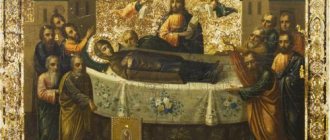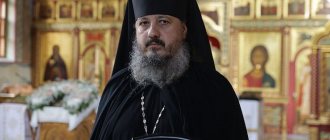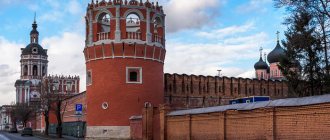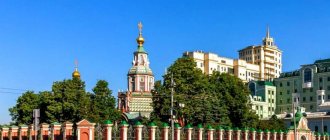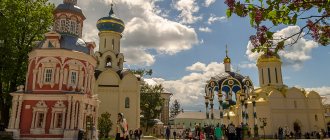| Icon of Pope Clement with scenes from his life in the background. Perm icon. First half of the 17th century |
Clement I
(Latin Clemens, Greek Κλήμης; + 101), Bishop of Rome, Hieromartyr Memory November 25, January 30 - discovery of relics ca. 855-967 [1], November 24 (Greek [2])
Born in Rome into a rich and noble family. Due to circumstances, separated from his parents since childhood, Clement was raised by strangers. Living in Rome, the young man received an excellent education, was surrounded by luxury, and close to the imperial court. But he was not pleased with pleasures, pagan wisdom did not captivate him. He began to think about the meaning of life. When news about Christ and His teaching reached the capital, Saint Clement left his home and estate and went to the lands where the apostles preached.
In Alexandria, Clement met the holy Apostle Barnabas, whose words he listened to with deep attention, perceiving with all his heart the power and truth of the Word of God. Arriving in Palestine, Saint Clement received baptism from the holy Apostle Peter and became his zealous disciple and constant companion, sharing with him his labors and sufferings. Clement was also a collaborator with the Apostle Paul in his apostolic preaching (Phil. 4:3). The Holy Apostle Peter, shortly before his suffering, ordained Saint Clement as bishop of the city of Rome. After the death of the apostle, and after him Saint Linus, Bishop of Rome (67-79), and his successor, Saint Anacletus (79-91), Saint Clement was at the Roman See (from 92 to 101).
The virtuous life, mercy and prayerful feat of Saint Pope Clement converted many to Christ. So, one day on Easter day, 424 people were baptized by him at once. Among those baptized were people of all classes: slaves, rulers, members of the imperial family. The pagans, seeing the success of his apostolic preaching, reported Saint Clement to the Emperor Trajan (98-117), accusing the saint of blaspheming the pagan gods.
| Sschmch. Clement of Rome celebrates the liturgy. Fresco in the Roman Cathedral of San Clemente (11th century) |
According to legend, the emperor expelled Saint Clement from the capital, sending him to Crimea to work in the Inkerman quarries near the city of Chersonesos.
Many of the saint's disciples followed him, preferring voluntary exile to separation from their spiritual father. Arriving at the place of exile, Saint Clement met many Christian believers, condemned to work in difficult conditions, completely without water. He prayed along with the condemned, and the Lord, in the form of a Lamb, showed him the place of the source from which a whole river flowed. This miracle attracted many people to Saint Clement. Listening to the zealous preacher, hundreds of pagans turned to Christ. Every day 500 people or more were baptized. And there, in the quarries, a temple was carved out in which he officiated. The saint's apostolic activity aroused the wrath of Emperor Trajan, and he ordered Saint Clement to be drowned. The martyr was thrown into the sea with an anchor around his neck. This happened in 101 [3].
Through the prayers of the faithful disciples of St. Cornelius and Thebes and all the people, the sea receded, and people found the incorruptible body of their shepherd at the bottom in a temple not made by hands (the Church of the Angels). After this, every year on the day of the martyrdom of Saint Clement, the sea receded, and for seven days Christians could venerate his holy relics. Only in the century, during the reign of the Constantinople Emperor Nicephorus (802-811), by God's permission, the relics of St. Clement became unavailable for veneration for 50 years.
| The myrrh-streaming head of the schmch. Clement of Rome. Distant caves of the Kiev Pechersk Lavra |
Under Emperor Michael and his mother Theodora (855-867), Equal-to-the-Apostles Cyril and Methodius visited Chersonesos.
Having learned about the hidden relics of Saint Clement, they prompted Bishop George of Chersonesos to conciliar prayer to the Lord for the discovery of the relics of the holy martyr. After the conciliar service of Saints Cyril and Methodius and the clergy who arrived with them from Constantinople and the fervent prayer of all those gathered on the surface of the sea at midnight, the holy relics of Bishop Clement miraculously appeared. They were solemnly transferred to the city to the Church of the Holy Apostles. Part of the relics was taken by Saints Cyril and Methodius to Rome, and the holy head was subsequently brought to Kiev by Saint Equal-to-the-Apostles Prince Vladimir (+ 1015) and, together with the relics of Saint Thebes, was placed in the Church of the Tithes, where a chapel was built in the name of Saint Clement. Nowadays the head of St. Clement is among the myrrh-streaming heads kept in the Far Caves of the Kiev Pechersk Lavra [4].
The memory of the holy martyr is sacredly revered in Russia. Since ancient times, many temples were dedicated to him.
Prayers
Troparion, tone 4
| Sschmch. Clement of Rome. Icon. Russian North (early 16th century) |
And from the God of miracles / gloriously surprising the universe, the ends of the world, / the most holy sufferer, / more than the nature of the sea, the compositions of the waters create division / in honor of your memory / always flowing bottom into the God-given church/ by your miraculous relics,/ and by the general walk/ the sea into one You work miracles,/ Wonderful Clemente, // pray to Christ God to save our souls.
Kontakion, tone 2
(Similar to: Solid:)
The divine grape is sacred/ the vine has appeared to everyone,/ dripping the sweetness of wisdom,/ through your prayers, most honorably,/ let us crush it for you, like a scarlet,/ we will bring a mental song,/ to St. Clement You, // save your servants.
Troparion, tone 2
, to find relics [5]
Do not turn us away, ashamed, Clemente, / falling in faith to your tomb, holy one, / but accept the slave of your hearts / who approach the race of your holy relics, praying, / as if you were blessed and generous let us make/ your flock enjoy your mercy,/ giving healing to God to the faithful/ and forgiveness and cleansing from sin,/ through your prayers, O glorious one,// and great mercy.
Martyrdom of Clement of Rome.
Nothing is known for sure about the life and death of Saint Clement of Rome. We learn about his biography mainly from apocryphal texts.
Around 110, Clement of Rome was sentenced to martyrdom by Emperor Trajan. Even before this, he was exiled to Crimea, but successfully preached there. According to historical data, thanks to his activities, more than 2,000 people living in Crimea became Christians, and more than 75 churches were built. Trajan ordered Clement of Rome to be tied to an anchor and thrown into the sea.
Proceedings
The undoubted proximity of the schmch. Clement to the two named apostles is the reason that two of the most important canonical monuments of the primitive church bear his name: “The Rules of the Holy Apostles” and “The Apostolic Decrees.” It has been proven, however, that both of these works in the edition in which they have survived to this day do not belong to him.
The affiliation of Clement's two district "Epistle to (Christian) virgins", which are in complete agreement with his true teaching, is also disputed by many.
Undoubtedly, his authentic creation is considered to be the “First Epistle to the Corinthians” known under his name, in which he tries to persuade the warring Corinthian parties to peace and subordinate them to the power of the legal hierarchy. It represents the first written monument of Christian teaching after the works of the apostles (written around the year after Christ) and enjoyed special respect in the ancient church: it was read in churches along with the apostolic epistles and it was included in the same codes with them .
The “Second Epistle to the Corinthians”, incompletely revealed for the first time, with the name of Clement, in the Alexandrian Codex of the Bible (5th century), and in its entirety found in 1875 by Metropolitan Nikephoros Bryennios in the Patriarchal Library of Constantinople, also aroused great controversy regarding its belonging to Clement, which, however, is more than likely. This epistle is nothing more than a homily pronounced by Clement in Rome and, with some changes, sent by him in the form of an epistle to Corinth, and represents an example of those primitive church teachings that were composed following the example of the apostolic instructions and in accordance with their requirements for the artlessness of teacher speech.
Clement of Rome is also credited with an essay known as “Clementine,” which contains a comparative presentation of the teachings of Judaizing Christians and pagan Christians: the author noticeably leans toward the side of the former. One edition of them is called: “Conversations (homiliae) of Clement of Rome”; here, in lively and even artistic speech, the travels of the Apostle Peter are told, about his debates with Simon the Magus, Appian, Athenodorus, etc. Another edition is called “Memoirs (recognitiones) of Clement” and represents a common and varied version of the previous one. In it, Clement appears as the apostle's companion on his travels, during which Clement finds his parents and brothers, about whom he knew nothing for a long time, and has conversations with them. The Apostle Peter is here an ardent supporter of the Judaizing Christians, developing views close to the teachings of the Ebionites, in contrast to Simon the Magus, who appears to be a defender of the views of Paul, the Apostle of the Gentiles. In addition, the following are known: a) an abbreviation (epitome) of conversations and b) fragmentary fragments from “conversations” and “memoirs”. The origin of "Clementine" dates back to no earlier than 171 and no later than 217 (they are first mentioned by Origen, around 230). They usually think that “Clementine” is the work of one of the Syrian heretics of the second century: this is proven by the fact that the relationship between the two first persons of St. The Trinity is presented here in disagreement with Holy Scripture, the eternity of torment is rejected and Jesus Christ is placed along with Moses. As a monument to the apocryphal literature of primitive Christianity, the Clementines are not without interest, and in this sense they were diligently studied by Baur and other scientists of the Tübingen school.
Of the old editions of the works of Clement of Rome, the best is Minya, “Patrologiae cursus” (ser. lat., vol. I); then Hilgenfeld, “Novum Testamentum extra canonem receptum.” “Recognitiones” was published by Gerzdorf (Leipzig, 1838), homilies by Lagarde (Leipzig, 1865), Epistles to Virgins by Beelen (Louvain, 1856). The newest edition of one Greek text - Metropolitan Bryennios (Constantinople, 1875).
Russian translation of the messages - in “Monuments of Ancient Christian Writing” of 1861 and in the publication of Preobrazhensky (Moscow, 1875); the second message is here only in the amount of the first 12 chapters; the Russian translation of the remaining eight chapters found by Bryennius is in the work of Professor N.I. Barsova: “The History of Primitive Christian Preaching” (St. Petersburg, 1885); There is also an indication of all the literature about Clement of Rome.
Fourth Pope.
St. Clement of Rome was the third successor of the Apostle Peter as Bishop of Rome, and therefore is the fourth Pope. His ministry as Pope most likely lasted from 92 to 101. His predecessors are Linus/Lin and Cletus/Clet.
According to Tertullian, Clement of Rome was ordained by Saint Peter. St. Jerome claimed that Clement was the immediate successor of the Apostle Peter. Clement was the fourth Pope.
Origen identifies Pope Clement I with a fellow colleague of Paul who is mentioned in the Epistle to the Philippians.
I ask you, sincere co-worker, to help them, who labored in the gospel together with me and with Clement and with my other co-workers, whose names are in the book of life.
However, there is no way to confirm or refute this version. There is no convincing evidence that Clement of Rome was personally acquainted with at least one of the apostles.
Some also identify Clement of Rome with the consul Flavius Clement, who was killed by his cousin at the end of his consulate, however, this is a mistaken opinion. It is unlikely that Clement of Rome was a member of the imperial family. The constant use of quotations from the Old Testament in theological works indicates that Clement of Rome was probably of Jewish origin.
It is also very likely that he was a freedman or the son of a freedman. His family may have lived in Rome.
Hieromartyr Clement, Pope of Rome. Orthodox calendar for December 8
Main church holidays, days of remembrance of saints and Orthodox shrines of today
December 8 (November 25 according to the “old style” - the church Julian calendar). Week 25 after Pentecost (twenty-fifth Sunday after the feast of the Holy Trinity, Pentecost). Christmas post. According to the Church Charter, Lenten food with fish is blessed at the meal. Today in the Russian Orthodox Church the celebration of the Feast of the Entry into the Temple of the Most Holy Theotokos and the memory of 20 saints known to us by name. Next we will briefly talk about them.
***
Hieromartyr Clement, Pope of Rome . In Moscow's Zamoskvorechye there is a temple first mentioned at the beginning of the 17th century . A church with a somewhat unusual name for Orthodox ears - the Hieromartyr Clement, Pope of Rome. But it is only during the last thousand years that we perceive the heads of the Roman throne as having moved away from Orthodoxy. In the very first centuries of Christianity, these were the true heirs of the supreme apostle Peter. And one of the first among them was Saint Clement .
Orthodox Pope: December 8 - commemoration of the Hieromartyr Clement, Pope of Rome
Hieromartyr Clement was born in Rome into a noble family, received an excellent education, was surrounded by luxury and close to the imperial court. But having learned about Christ, young Clement left his home and estate and went to the lands where the apostles preached. Arriving in Palestine, he received Baptism from the Apostle Peter and became his zealous disciple. And shortly before his martyrdom, the Apostle Peter ordained Saint Clement bishop of the city of Rome.
In the 9th century , Chersonese was visited by Equal-to-the-Apostles Cyril and Methodius . After the conciliar service of these saints and the clergy who arrived with them from Constantinople, the holy relics of Bishop Clement miraculously appeared on the surface of the sea. After this, they were solemnly transferred to the temple. And today, remembering the martyrdom of the Holy Martyr Clement, Pope of Rome, we must understand how difficult it was to preach the Word of God in the first centuries of Christianity. But the divinely inspired works of these very people in those years changed the whole world.
Photo: pravoslavie.ru
***
Hieromartyr Peter, Archbishop of Alexandria . Hierarch of the Church of Christ of the late 3rd - early 4th centuries , one of the first denouncers of the heretic Arius. The last of the Alexandrian martyrs, who accepted suffering and death for fidelity to the Christian faith, preaching the Word of God and archpastoral labors in 311 AD, during the period of anti-church persecution by the pagan emperor Maximin. When Vladyka Peter himself went out to his execution to meet his executioners, a voice from Heaven announced:
Peter is the beginning of the apostles, Peter is the end of the Alexandrian martyrs.
The saint left behind many theological works, including “On the Divinity,” which was subsequently read at the Councils of Ephesus and Chalcedon, as well as the famous “Rules.”
Hieromartyr Peter, Archbishop of Alexandria. Photo: pravoslavie.ru
Venerable Peter of Galatia . Little is known about Saint Peter from hagiographic literature. As a nine-year-old boy, he left his parental home and, in aspirations for spiritual life, first went to the Holy City of Jerusalem, and then to Antioch, where he secluded himself as a hermit in a cave. Here Saint Peter devoted himself to the feats of prayer and strict abstinence for many years, only every other day he accepted bread and water. The Lord honored Saint Peter with the gift of working miracles, healing bodily ailments and casting out demons. The Monk Peter of Galatia departed to the Lord around 429 , being a 99-year-old old man. Of such long years of his earthly life, he devoted ninety to unceasing service to God.
Venerable Martyr Magdalene (Zabelina; 1931), Hieromartyr Seraphim (Ostroumov), Archbishop of Smolensk, Gregory Voinov, John Tarasov, Vasily of Pariysky, Cosmas Korotkikh, John of Vladimir, Simeon Afonkin, Hilarion Solovyov, Yaroslav Savitsky, Alexander Vershinsky, John Yanushev, Viktor Smirnov, Andrei Shershnev, Varlaam Popov, presbyters, martyrs Pavel Kuzovkov (1937) and Nikolai Kopninsky (1938) . Clergy (including those in the rank of bishop), nuns and laity of the Russian Church who suffered for their loyalty to Christ during the period of Soviet atheistic persecution. They were glorified among the saints among the many thousands of new martyrs and confessors of the Russian Church.
***
Congratulations to Orthodox Christians on the memory of all today's saints! Through their prayers, Lord, save and have mercy on us all! We are happy to congratulate those who received names in their honor through the Sacrament of Holy Baptism or monastic tonsure! As they used to say in Rus' in the old days: “A golden crown for the Guardian Angels, and good health for you!” To our departed relatives and friends - eternal memory!
CLEMENT I
CLEMENT I (lat. Clemens), Clement of Rome (? - c. 101, Chersonesus Tauride, now the territory of Sevastopol, Crimea), apostle of the seventy, one of the apostolic men, Pope of Rome (c. 92 - c. 101), father and teacher of the Church, martyr.
According to the testimony of Sschmch. Irenaeus of Lyons, K. I saw the apostles Peter and Paul, communicated with them, listened to their sermon. According to Tertullian, Jerome the Blessed and Bishop. Epiphanius of Cyprus, K. I was ordained bishop by the ap. Peter, occupied Rome. department after Linus and Anacletus. According to Eusebius of Caesarea, K. I died in the third year of the emperor's reign. Trajan, the successor of K. I was Evaristus. There are known examples of Romans turning to Christ, from slaves to members of the empire. family, thanks to the preaching of Clement I.
"Saint Clement I". Detail of a mosaic on the south wall of the central nave of the Basilica of Sant'Apollinare Nuovo in Ravenna. 6th century
The authority of K. I already in the ancient Church contributed to the fact that various things were attributed to him. essays. However, the only one that does not raise doubts about its authorship is the “First Epistle to the Corinthians of Clement of Rome,” created in Greek. language during the reign of the Emperor. Domitian (81–96). The message was written by K. I on behalf of Rome. church to the Corinthian church regarding the discord that occurred between believers, and tells about the hierarchical. the structure of church life, the need for apostolic succession of the primates of churches. The Epistle is one of the oldest and most authoritative monuments of Christian writing; already in ancient times it was widespread. According to the testimony of Eusebius of Caesarea, it was read in churches during divine services along with the apostolic epistles and was placed in the same codices as them.
K. I is attributed to the collection of works “Clementina”, or “Pseudo-Clementine”, which belongs to the apocrypha. “Clementines” are on a par with numerous. apocryphal Acts of the Apostles, compiled in the first centuries of Christianity. The collection combines 5 monuments: “The Epistle of St. Peter to James the Righteous, first bishop. Jerusalem", with which the so-called is connected. "Testimony for those who receive the book"; "Epistle of Clement to James"; 20 "Conversations"; “Meetings” (“Recognitions”, Greek 'Aνaγυώσεις, Latin Recognitiones) in 10 books, the edition of which has been preserved in Lat. translation of the 4th century. Rufinus of Aquileia; so-called "Abridgement of the Acts of Peter." K. I is also credited with the “Second Epistle to the Corinthians of Clement of Rome,” “Two Circular Epistles to Virgins,” and some others.
It is believed that K. I (as well as Pope Fabian) took the initiative to compile the first collections of the lives of martyrs that have not reached us.
Later writers represent K. I as a martyr: his death is reported in the “Acts of Martyrdom,” dating back to the 4th century. According to these acts, C. I was exiled to Rome for the spread of Christianity. authorities to the outskirts of Rome. empire, in the quarry of Chersonese Tauride - tradition. place of exile for Christians. His missionary activity in Chersonesos aroused the wrath of the authorities: with a weight (anchor) tied around his neck, K. I was drowned in the sea. According to the “Life” (4th–5th centuries), his body, washed ashore, was buried by his students on a small island (in the modern Cossack Bay of Sevastopol). His relics were found in the beginning. 860s and on the initiative of Constantine the Philosopher (see Art. Cyril and Methodius) were transferred to Chersonesus. Then Constantine and Methodius brought part of the relics to Rome, where they are preserved to this day in the Basilica of St. Clement. Part of the relics remained in the cathedral church of Chersonesos (the so-called Uvarov Basilica) until the 10th century. Kyiv book Vladimir Svyatoslavich, returning to Rus' after the capture of Chersonesus, transferred part of the relics of K. I (the head) to Kyiv, where it subsequently remained in the Tithe Church; Now, according to church tradition, the chapter of K. I is in the Kiev Pechersk Lavra. These relics became the first Christian shrine in Rus'. In the 11th century the first Russian was written. essay about K. I - “A Word on the Renewal of the Tithe Church.” The first stone church in Rus' in his honor was founded in 1153 in Ladoga; Temples in Pskov, Veliky Novgorod, Tver, Moscow, and the Inkerman St. Clement Monastery are also known. (near Sevastopol).
Days of remembrance according to the Russian calendar. Orthodox Church - November 25 (Dec. 8), Apr. 22 (5 May), 10(23) Sept., 4(17) Jan. in the Council of 70 Apostles, in the Council of All Reverend Fathers, 15 (28) December. in the Cathedral of Crimean Saints; according to the Roman Catholic calendar. church - November 23.
